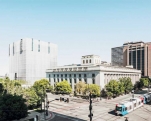U.S.Courthouse, Salt Lake City: Openness and Transparency

The design of the new Salt Lake City courthouse resulted from a search for a physical symbol to express the American system of justice—the form had to be strong, iconic, transparent, and egalitarian. The cubic massing of this courthouse captures all of these elements in a recognizable form that projects grounded dignity and substantive order and presents an equal face to all sides.
The new building stands respectfully beside the existing Frank E. Moss Courthouse (1905; additions, 1912 and 1932), a Classical Revival building with its own iconic presence. The two buildings are joined by an elevated landscaped garden, and together they establish a distinct federal precinct and architectural anchor at the southwest perimeter of the downtown.
The 400,000-square-foot building contains 10 courtrooms, 14 judges’ chamber suites, administrative Court Clerk offices, the U.S. Marshals Service, U.S. Probation, and other federal agencies.
The building’s clear glass and anodized aluminum skin admits abundant natural daylight to the interior and provides views from within. Vertical aluminum sunscreens on the exterior temper this transparency with a variable protective veil that modulates quietly with the passing of the sun. Vertical fluting of these delicate elements refers subtly back to the classical orders of the Frank E. Moss Courthouse and to the broader traditions of the judiciary.
In its interior planning, this LEED Gold® building celebrates daylight as an intrinsic quality of both public and individual space. A 10-story sky-lit atrium extends the height of the building and brings natural daylight to the centrally located public elevator lobbies. The atrium also features a 10-story suspended sculptural art installation by the American artist James Carpenter. The interior hanging mirror feature as a beautiful artistic piece that is also highly functional, saying that it is “truly unique” and exists to “share the light all the way through” interior core spaces.
The primary functions of the building—the courtrooms—occupy the four corners of the building, bathed in filtered natural daylight, bringing clarity and context to the proceedings within.
Full content of this issue you can read here
The full version of the article can be read in our printed issue, also you can subscribe to the web-version of the magazine
 Materials provided by Thomas Phifer and Partners
Materials provided by Thomas Phifer and Partners


